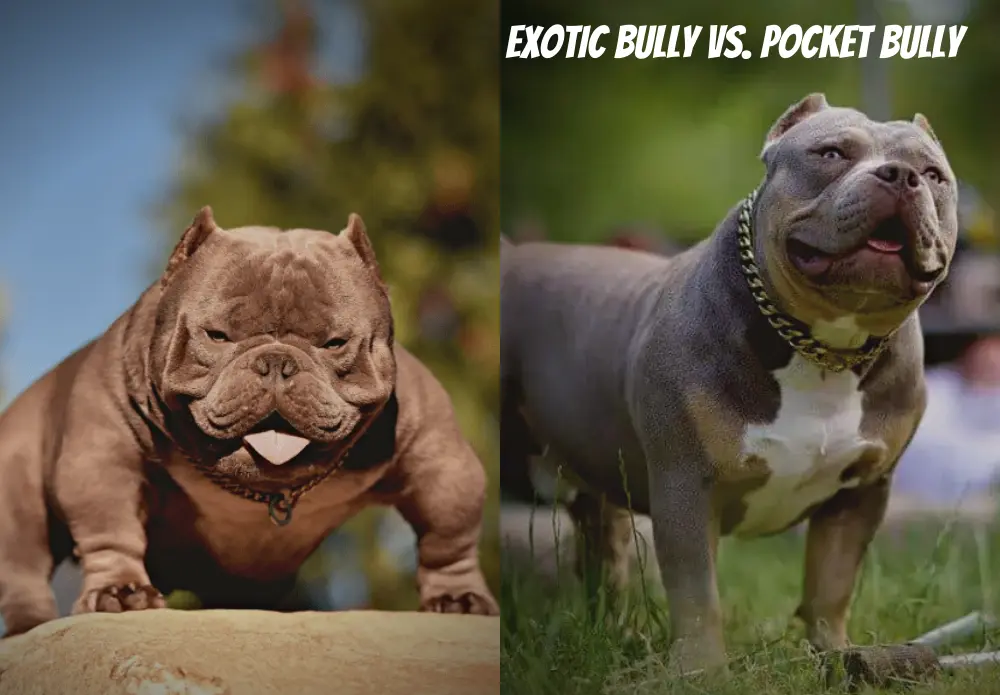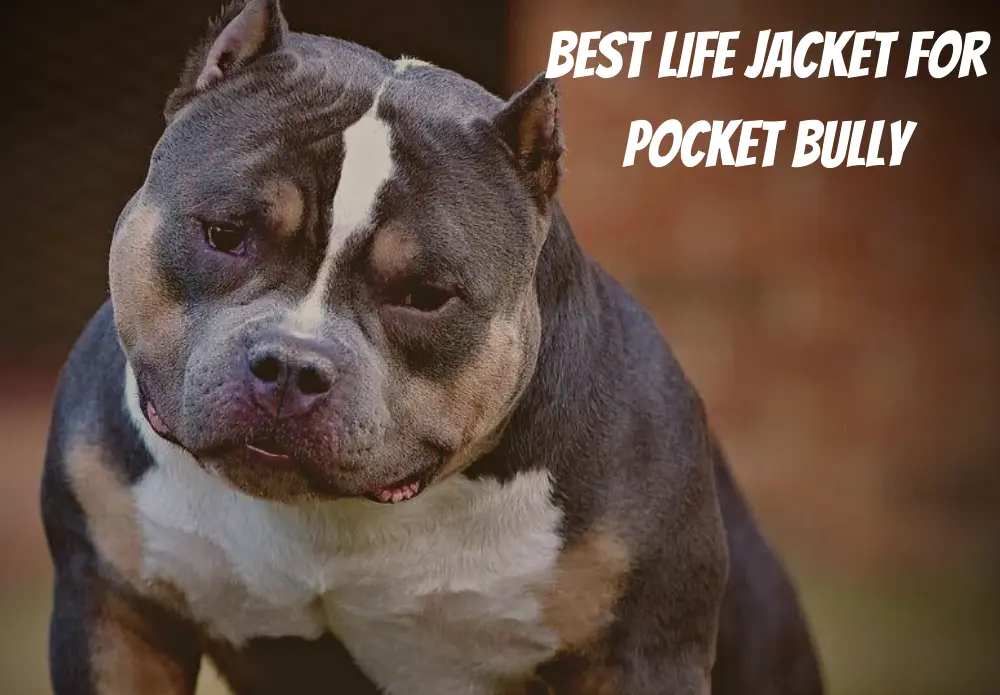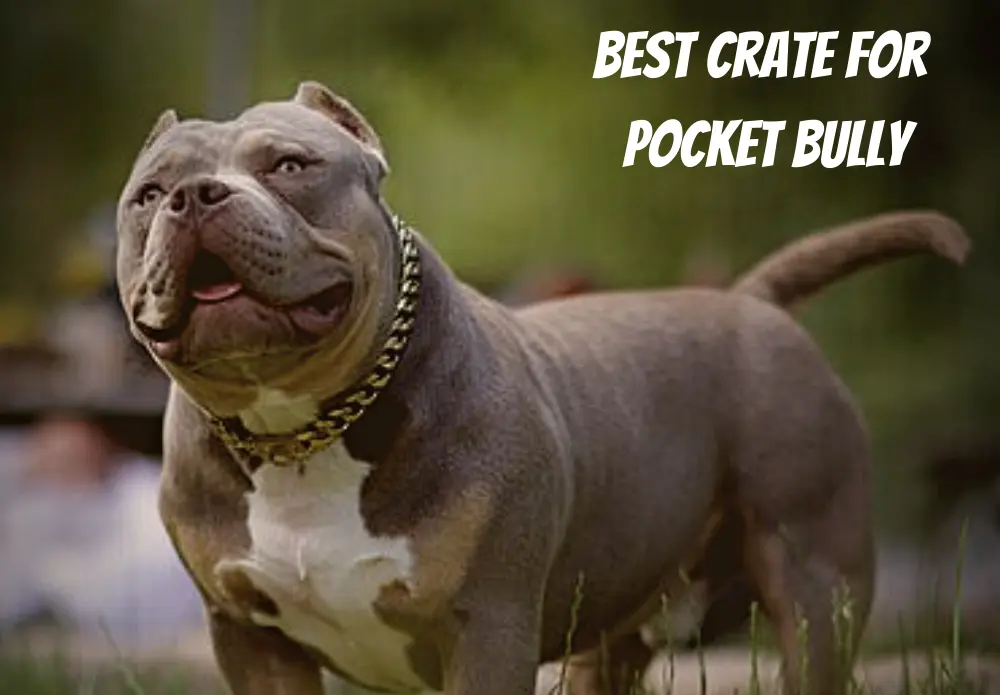If you have recently heard about the new breed called Exotic Bully, you may be looking for all the information you can find. Well, lucky for you, you have come to the right place.
I have collected all the information regarding the Exotic Bully and the Pocket Bully from personal experiences that will help you greatly. So, let’s understand in detail what all the fuss is about.
Origins of Exotic Bully and Pocket Bully
Exotic Bully is a type of American Bully with exaggerated characteristics of an American Bully in a small body. Exotic Bullies were bred by crossing American Bulldogs, American Bully, English Bulldogs, French Bulldogs, and Short Bulls.
Breeders have constantly bred all these different together to build a dog that has all the characteristics but in a compact body. Exotic Bullies are more muscular than Pocket Bullies.
Pocket Bullies are just standard bullies of a small size. Pocket Bullies were produced by mixing American Bully with Patterdale Terrier.
The first puppy of Exotic Bully was born in 2008 when everyone noticed it was a different breed and named it so. After 5 years of further selective breeding, the United States Bully Registry officially recognized the breed in 2013.
The official registration gave recognition to the breed, and it gained exponential popularity. The original parents of the breed were American Bully, French Bulldog, and American Bulldog.
The reason to mix in the French Bulldog is to get a smaller size. The Pocket Bully was first produced in the late 1990s and registered in 2008 by the ABKC.
Exotic Bully vs Pocket Bully
The physical characteristics set the Exotic Bully apart from other Bully breeds. They are smaller than standard American Bullies but the same size as Pocket Bully. So let’s take into detail all the characteristics of the breed.
Size and weight
Exotic Bullies reach a height of 11 inches to a maximum of 13 inches, and they weigh between 30 to 50 pounds. The females grow from 10 to 12 inches and weigh slightly less than males, between 25 to 25 pounds.
A Pocket Bully typically weighs between 10 and 22 pounds and stands between 13 and 17 inches tall, depending on the gender.
Appearance
As similar as they sound and may look at first glance, they look different. You will see the clear difference if you put them next to each other. They have different body structures, various sizes, and different coats.
It’s common to mistakenly identify both breeds at first look, particularly if you don’t know anything about them.
However, you can quickly identify them by their outward appearance once you know them. Although both breeds have broad heads and muscular bodies, Exotic Bully’s heads are marginally larger.
An exotic Bully is comparable to an overdone Pocket Bully in some respects. Compared to Pocket Bully, they have more exaggerated characteristics like wrinkled faces, muscle, flatter faces, and shorter muzzles.
The Muscular Build
Both types are built with muscles. Compared to Pocket Bully, Exotic Bullies have a stockier build and a brawnier figure. The Pocket Bully’s body bulk gives them a beefy, hulking appearance, but the Exotic Bullies look the best overall. Despite being small, they have a larger amount of body fat.
Unquestionably, this breed has the most muscle. You can see strength and dominance when a Pocket Bully walks down the street. However, Exotic Bully has a leg up on Pocket Bully. When you see an Exotic Bully walking through the streets, you get the impression that a fighter is returning from a victory. Or a bodybuilder just returned from the gym.
Coat
The coats of the two breeds are comparable. They lack an undercoat and have short hair with smooth bodies. The hair is uniformly short and short all over. The surface has a soft, lustrous finish. Since they only have a single coat, they can’t live in frigid climates.
Since they are not prone to tangles and hair ties, grooming is not difficult. A rubber mitt and a fine-tooth comb are the best tools to brush their hair. Their coat will appear shiny if you give them a once-over every so often.
Lifespan
Both Exotic and Pocket Bullies are similar but don’t live the same. This is because these dogs are muscular and can easily get overweight.
Pocket Bullies can live up to 8-15 years, whereas Exotic Bullies live less at 8 to 10 years. Both breeds need daily exercise as they can easily put on weight and become obese.
Health issues
No matter how healthy a Pocket Bully or an Exotic Bully may be, they still experience health problems like all other dogs. Exotic and Pocket Bullies generally have similar health problems.
Genes or aging are two factors that can contribute to some generic issues. However, some problems are brought on by the owner’s carelessness and starvation. The issues that both types must deal with are as follows:
Hip Dysplasia
It is one of the most common health issues among dogs, regardless of breed. After a certain age, this issue arises in every dog. Due to the hip joints’ malformation in this illness, pain is present.
The hip is malformed when the joint and socket rub against each other. The dog’s pain makes it uncomfortable and challenging to move. These are the signs of this illness:
- Body appears thin
- Fewer activities
- Lameness
- Difficulty moving and standing up
Thyroid Disease
The Bully family is afflicted by this illness frequently. Do a thyroid disease examination if you suspect your dog is putting on weight and exhibiting skin issues. The dog’s metabolism is impacted when the thyroid glands cannot produce enough thyroid hormones. These are a few signs of the illness:
- Loss of appetite Lethargic.
- Obesity
- Anemia
- Skin conditions
Knee Complications
Both of these breeds are extremely energetic and enjoy running. The cranial cruciate ligament is impacted by this exercise, which affects the dogs’ ability to move freely.
This painful health condition causes the dog to limp while walking and starts with a partial tear in the ligament. Usually, the condition worsens due to the dog’s continued physical activity.
Cataracts
Pocket Bullies and Exotic Bullies are prone to cataracts more than any other breed. Because it is inherited, Exotic Bullies are more likely to develop this disease than Pocket Bullies.
Diabetes, uveitis, and hypocalcemia are a few other diseases that can result from cataracts. Depending on the cataract’s condition, it may be treated with medicine or surgery.
Heart Disease
The parent dogs of both breeds are typically the source of heart illness. Aortic stenosis, which affects the health of both Exotic Bullies and Pocket Bullies, is the most prevalent form of heart disease. This condition has no signs at all. It is advised to regularly have your dog diagnosed early so that treatment can begin promptly.
Taking Care of Exotic and Pocket Bully
Diet
Both of these breeds have muscular builds and the same nutritional needs. Both need a diet high in protein, fat, and necessary carbohydrates.
The Bullies could eat anywhere from 1.5 to 5 containers daily. It follows that the weekly cost of food may be entirely different or nearly the same. For specific guidance, you should ultimately adhere to the feeding and packaging directions for the food.
Grooming
Thankfully, the coats on both of these puppies are simple to maintain. To keep their straight, short hair appearing healthy and shiny, they only need to be brushed once a week. It will distribute natural coat oils, get rid of dead hair and dirt, and be a relaxing time with your dog.
A short bristle brush would be a wonderful brushing tool for both of these guys. Pocket Bullies and Exotic Bullies both sweat on average. Both do not shed their coats on a seasonal basis, which appeals to many proprietors.
Once every two to three months, both breeds should get baths. Or as and when they require it if they get dirty while on their walkies. Just once every month at most.
It is advised to use a shampoo made for dogs with sensitive skin when shampooing either of these puppies. At least twice a week, they should clean their teeth. Due to their increased risk of periodontal illnesses, you might need more if you have a small Bully.
Exercise
Both dogs require roughly the same amount of activity. They must exercise for 60 minutes daily to be cheerful and healthy. These two men aren’t sofa potatoes. The hefty Pocket Bully is included!
The Pocket Bully would be the type of choice if we had to pick one more active than the others. The Pocket Bully requires more cerebral stimulation throughout the day because it is more athletic and agile. Because of their Pitbull and Bulldog ancestry, the Bully enjoys relaxing after workouts.
Choose a durable toy that can endure their constant play because both breeds are tenacious and rough. Both Bullies are considered a little smarter, so buy them some puzzle games to keep them occupied. You shouldn’t have a bored dog on your hands if you keep their exercise diverse and give them interactive play.
Keeping them both on leashes when the public is recommended due to their feared reputation. All dogs have a certain amount of unpredictable behavior, even though they aren’t the aptest to cause trouble.
Whatever dog you select, you should also research the BSL regulations in your area. According to some states’ laws, bully-type dogs must be muzzled in public, and some do not allow entrance to doggy parks.
Training
Both dogs have slightly varying training requirements and capacities. Bullies are intelligent and anxious to please dogs that respond well to training. He is suitable for new dog owners with a little study on dog training.
Again, the Bully can be a little more obstinate and defiant because of his Bulldog ancestry. Exotic Bullies need a more seasoned dog owner who can harness their independence and bring out the best in them.
Both of these dogs need to be socialized from the beginning. Before you bring the dog home, a good breeder will begin teaching them. Then it will be up to you to carry on. You should combine the two with as many pets and people as possible.
Additionally, expose them to various sights, noises, and smells. Positive reinforcement teaching works best for both dogs, so look into it and apply it.
No dog should ever be subjected to harsh handling or teaching methods. This is particularly true for strong dogs like these since crossing the two can result in dangerous dogs. Learn what inspires your dog the most. Treats will likely motivate the Pocket Bully, and trinkets will likely encourage the Exotic Bully.
Both dogs yearn for human company. It is impossible to be with them constantly, no matter how much we would like to and how much they merit it.
All dogs should be trained to use crates, but those prone to separation anxiety should be taught the most. Since all dogs need shelter, find the ideal dog crate for Bullies. I also predict that your “mean” Bully-type dog will take his favorite toys inside.
Puppy Prices
A Pocket Bully will cost between $3,000 to $8,00, while an Exotic Bully will cost you $5,000 but can easily reach $10,000 or more based on coat color and appearance.
FAQs – Frequently Asked Questions
What Is the Difference Between a Pocket Bully and Exotic Bully?
In essence, pocket bullies are the American Bully breed in a tiny size. Exotic Bullies aren’t purebred; they are a cross between an American Pit Bull Terrier., American Bulldog, French Bulldog, and a Patterdale Terrier. You shouldn’t mistake them for a genuine purebred miniature breed.
What Makes an Exotic Bully an Exotic Bully?
Out of all the bully breeds that are now available, most bully breeders believe that the Exotic Bully possesses the traits that are most in demand. They are smaller than other dogs but have less body fat, greater muscle, a larger head, a rounder face, and more wrinkles. We refer to them as “exotic” as a result.
Conclusion
Everyone has their preferences for selecting a dog. The Exotic Bullies are more ‘exotic’ than normal pocket Bullies, so that you can expect a high demand for them.
Exotic Bullies are more muscular and ripped than Pocket Bullies, and that’s what people love about them. Pocket and Exotic Bullies have fresh coats that are easy to groom. They also make excellent pets thanks to their high intelligence and loyalty.






